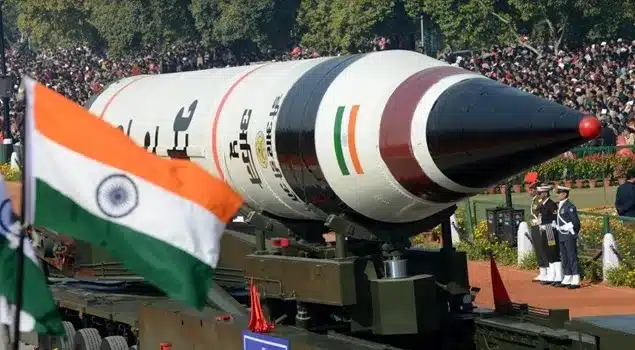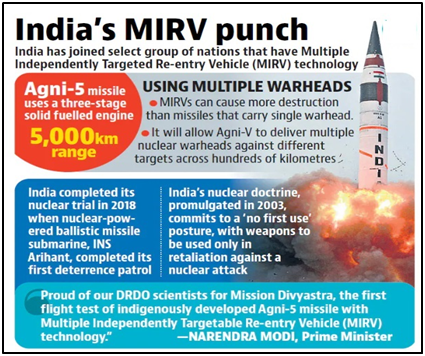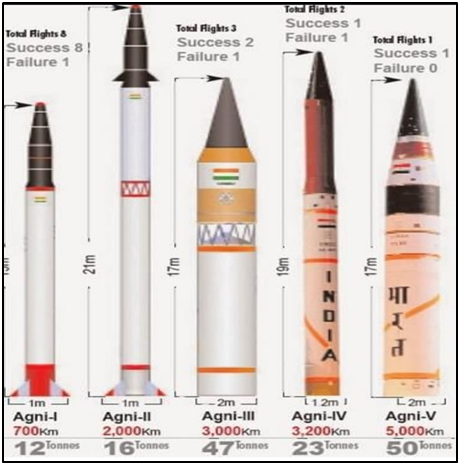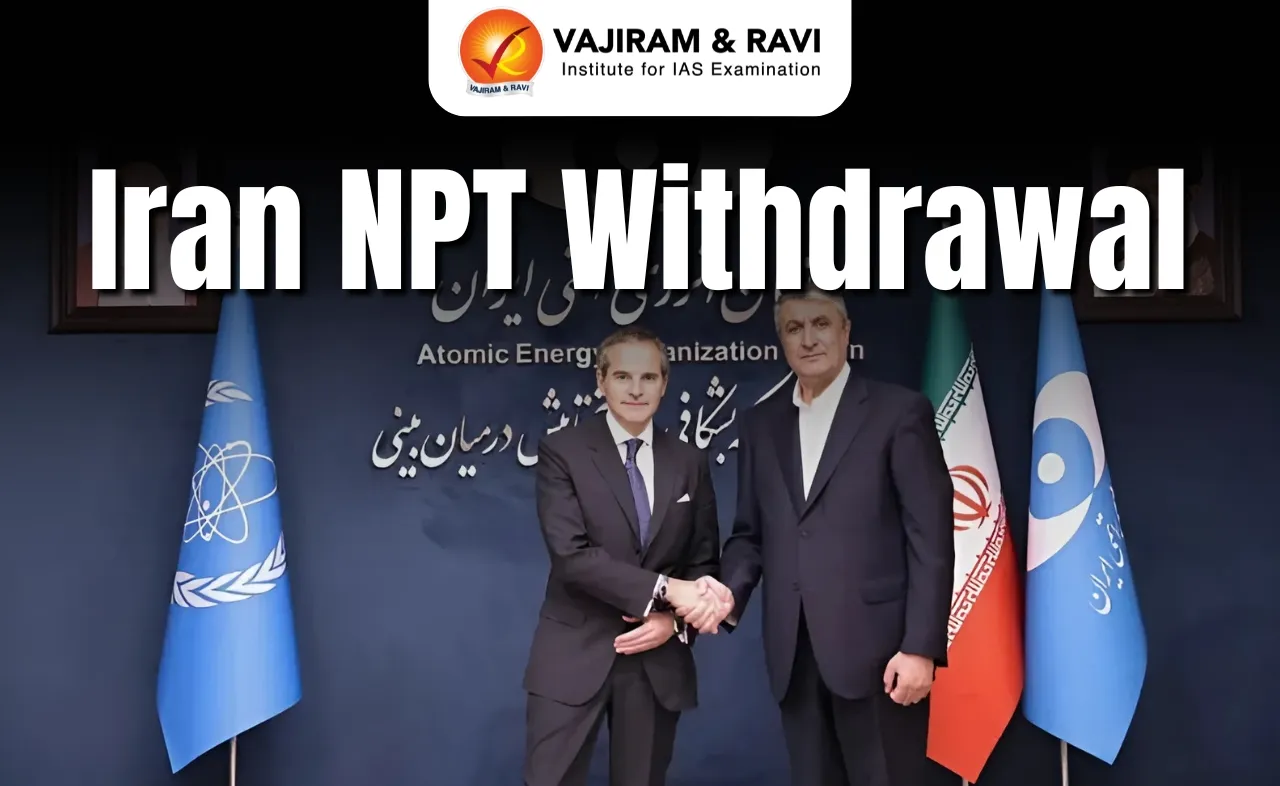What’s in today’s article?
- Why in news?
- What is Multiple Independently Targetable Re-entry Vehicle (MIRV) technology?
- What are Agni Missiles?
- What are Agni-5 missiles?
Why in news?
- India has announced the successful testing of an Agni missile capable of carrying multiple warheads meant to hit multiple targets simultaneously.
- The test was carried out from Dr APJ Abdul Kalam Island off the Odisha coast.
- The success of Mission Divyastra was announced by PM Modi.
- This technology will ensure that a single missile can deploy multiple war heads at different locations.
- This system is equipped with indigenous avionics systems and high accuracy sensor packages, which ensured that the re-entry vehicles reached the target points within the desired accuracy.
Multiple Independently Targetable Re-entry Vehicle (MIRV) technology
- About
- The MIRV can target multiple targets that can be hundreds of kilometers apart with a single missile.
- As of now, the United States, Russia, China, France and the United Kingdom are known to have MIRV-equipped missiles.
- While Pakistan is developing such a missile system, Israel too is suspected to either possess the missile or be developing it.
- These missiles can be launched from land or from sea (or from a submarine).
- Background
- MIRVs were originally developed in the early 1960s to allow a single missile to carry multiple nuclear warheads, each capable of striking different targets.
- The inception of MIRV technology was done by the United States with deploying:
- a MIRVed Intercontinental Ballistic Missile (ICBM) in 1970 and
- a MIRVed Submarine-Launched Ballistic Missile (SLBM) in 1971.
- What makes MIRV technology especially lethal?
- In contrast to a traditional missile, which carries one warhead, MIRVed missiles warheads can be released from the missile at different speeds and in different directions.
- The development of MIRV technology is not easy.
- It requires the combination of large missiles, small warheads, accurate guidance, and a complex mechanism for releasing warheads sequentially during flight.
- India and MIRV
Agni Missiles
- About
- Over the years, India has been able to acquire a credible minimum nuclear deterrence. In this, the Agni missile system is integral to India’s counter second-strike capability especially against China.
- The Agni category missiles are solid propelled ballistic missiles, ranging from short range missiles to intermediate range missiles (700-5000kms).
- The road and rail mobility of this series provides greater chances of survivability.
- History of Agni Missiles
- The Agni missile is a component of the Integrated Guided Missile Development Program (IGMDP) that was launched by India in 1983.
-
- In 1989, India test fired Agni 1 category missile
- Missiles in Agni Family
- The family consists of short to long range surface to surface ballistic missiles. These are
- Agni I – short-range ballistic missile (range – 700 to 1200 km)
- Agni II – medium-range ballistic missile (range – 2000 to 3500 Km)
- Agni III – intermediate-range ballistic missile (range – 3000 to 5000 Km)
- Agni IV – intermediate-range ballistic missile (range – 3500 to 4000 Km)
- Agni V – Inter-continental ballistic missile (range -5500 to 8000 Km)
Agni-5 missiles
- Agni is a long-range missile developed indigenously by DRDO.
- This latest variant of the missile is equipped with what is known as MIRV (Multiple Independently Targetable Re-entry Vehicle) technology.
- This Agni, capable of carrying nuclear warheads, has a range of more than 5,000 km, making it a long-range missile.
- India announced the development of Agni V in 2007.
- The maiden flight test of Agni-V was conducted in April 2012.
- Agni-V uses a three-stage solid fuelled engine and can reach most parts of China. It is aimed mainly at thwarting the challenge from China.
Q1) What is Defence Research and Development Organisation (DRDO)?
The Defence Research and Development Organisation (DRDO) is a defense research and development (R&D) agency under the Ministry of Defence in India. DRDO’s mission is to achieve self-reliance in critical defense technologies and systems, while equipping the armed forces with state-of-the-art weapon systems and equipment.
Q2) What is Integrated Guided Missile Development Programme (IGMDP)?
The Integrated Guided Missile Development Programme (IGMDP) was a program by the Indian government to develop a range of missiles. It was conceived by Dr. A.P.J. Abdul Kalam, the Director of the Defence Research & Development Laboratory (DRDL) at the time, and launched in 1982–83. The program ended in 2008.
Last updated on June, 2025
→ UPSC Notification 2025 was released on 22nd January 2025.
→ UPSC Prelims Result 2025 is out now for the CSE held on 25 May 2025.
→ UPSC Prelims Question Paper 2025 and Unofficial Prelims Answer Key 2025 are available now.
→ UPSC Calendar 2026 is released on 15th May, 2025.
→ The UPSC Vacancy 2025 were released 1129, out of which 979 were for UPSC CSE and remaining 150 are for UPSC IFoS.
→ UPSC Mains 2025 will be conducted on 22nd August 2025.
→ UPSC Prelims 2026 will be conducted on 24th May, 2026 & UPSC Mains 2026 will be conducted on 21st August 2026.
→ The UPSC Selection Process is of 3 stages-Prelims, Mains and Interview.
→ UPSC Result 2024 is released with latest UPSC Marksheet 2024. Check Now!
→ UPSC Toppers List 2024 is released now. Shakti Dubey is UPSC AIR 1 2024 Topper.
→ Also check Best IAS Coaching in Delhi

























